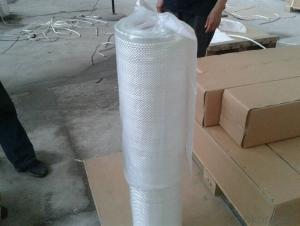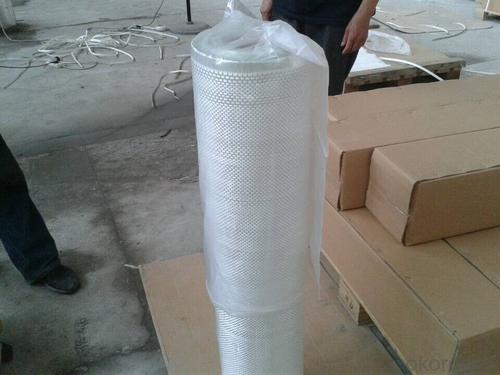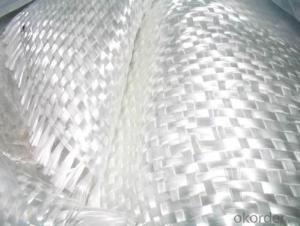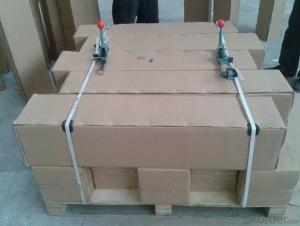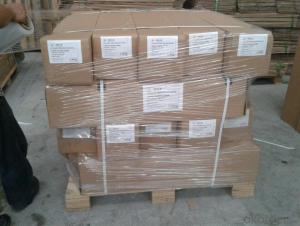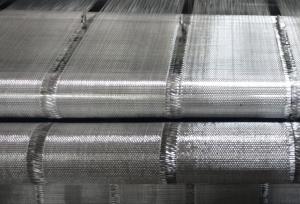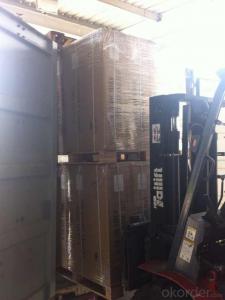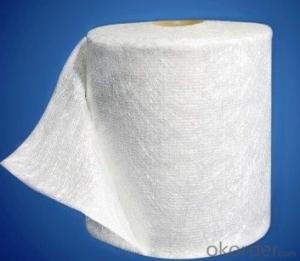Fiberglass Mat Tissue C Glass Woven Roving for FRP Application
- Loading Port:
- China Main Port
- Payment Terms:
- TT or LC
- Min Order Qty:
- 17600 m²
- Supply Capability:
- 17600kg Per Month m²/month
OKorder Service Pledge
OKorder Financial Service
You Might Also Like
Product Description
Glass woven rovings are bidirectional fabric made by direct rovings in plain weave pattern.
Compatible with unsaturated polyester,vinylresin ,epoxy resin.
Applicable for hand lay-up, winding and compress molding process,Suitable for manufacturing tank,boat,automobile parts and other FRP products.
Consistent thickness and excellent surface treatment.
Rapid impregnating and good compatibility with resin.
Uniform tension,high dimensional stability and making handing easy.
Good mechanical properties and high strength of parts.
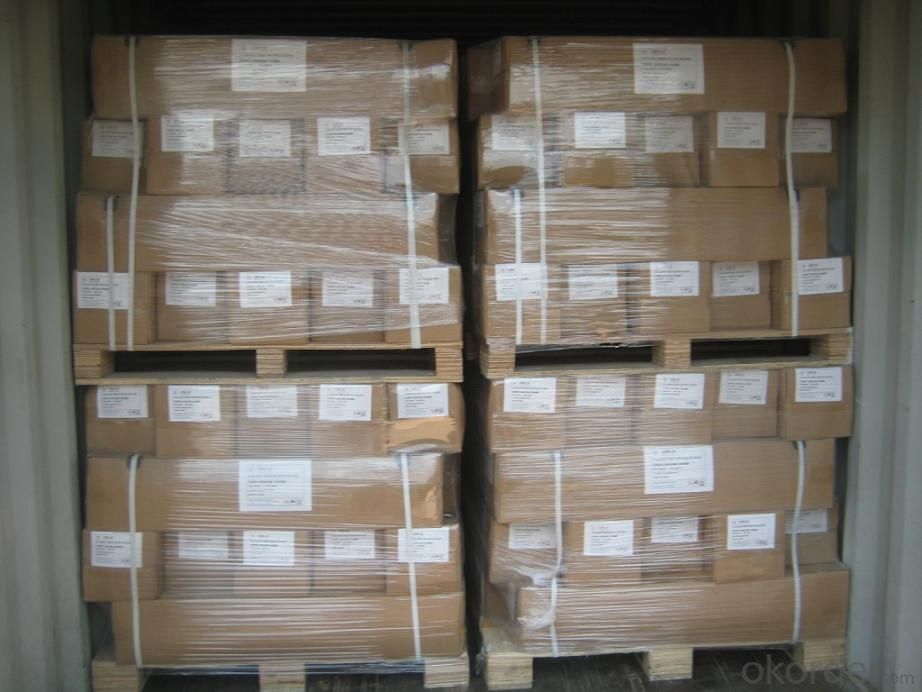
Technical Data Sheet
Style | Yarn(Tex) | Density(ends/10cm) | (g/m2) | Width(cm) | Tensile strength(N/50mm) | ||
Warp | Weft | Warp | Weft | ||||
EWR200 | 200 | 50 | 50 | 200±16 | 90/100 | ≥1300 | ≥1100 |
ERW400 | 600 | 35 | 32 | 400±32 | 100/127 | ≥2500 | ≥2200 |
EWR570 | 1150 | 26 | 24 | 570±45 | 100/127 | ≥3600 | ≥3300 |
EWR600 | 1200 | 26 | 24 | 600±48 | 100/127 | ≥4000 | ≥3850 |
EWR800 | 2400 | 18 | 16 | 800±64 | 100/127 | ≥4600 | ≥4400 |
CWR135 | 150 | 50 | 40 | 135±10 | 90/100 | ≥750 | ≥600 |
CWR180 | 200 | 50 | 50 | 200±16 | 90/100 | ≥1150 | ≥1000 |
CWR290 | 450 | 35 | 30 | 290±22 | 90/100 | ≥1500 | ≥1400 |
CWR310 | 500 | 35 | 28 | 310±24 | 90/100 | ≥1600 | ≥1500 |
CWR330 | 500 | 35 | 31 | 3300±26 | 90/100 | ≥1700 | ≥1600 |
CWR350 | 500 | 35 | 35 | 350±28 | 90/100 | ≥1800 | ≥1700 |
CWR400 | 500 | 40 | 40 | 400±32 | 90/100 | ≥2000 | ≥1900 |
CWR600 | 1200 | 26 | 24 | 600±48 | 100/127 | ≥2750 | ≥2600 |
CWR800 | 2400 | 18 | 16 | 800±61 | 100/127 | ≥3000 | ≥2900 |
FAQ
Package and Storage:Eech roll is packed by polyester bag,and then put into a cardboard box or plastic wowen bag.The weight of each roll is between 20 to 85 Kg, The rolls are to be horizontally placed and could be in bulk or on pallet.Optimum storage conditions are between the temperature of 5~35℃ and with the humidity between 35%~65%.The product should be used within 12 months from the time of delivery and remain in theiroriginal packaging until just prior to use.
- Q: How does the fiber distribution of fiberglass mat tissue affect its strength?
- The fiber distribution of fiberglass mat tissue has a significant impact on its strength. The strength of fiberglass mat tissue is primarily derived from the fibers embedded within the material. These fibers provide reinforcement and help to distribute stress and load evenly across the surface. The distribution of fibers in fiberglass mat tissue refers to how the fibers are arranged and oriented within the material. If the fibers are evenly distributed, with a uniform arrangement and orientation, the strength of the fiberglass mat tissue will be enhanced. This uniform distribution allows for efficient load transfer from one fiber to another, leading to improved overall strength. On the other hand, if the fiber distribution is uneven or random, with fibers clumped together or oriented in different directions, the strength of the fiberglass mat tissue will be compromised. Uneven distribution can result in stress concentrations at certain areas, leading to weak points and potential failure under load. Furthermore, the fiber length and density also play a role in determining the strength of fiberglass mat tissue. Longer fibers provide greater reinforcement and improve the overall tensile strength of the material. Additionally, a higher fiber density, meaning more fibers per unit area, increases the strength and overall performance of the fiberglass mat tissue. In summary, the fiber distribution of fiberglass mat tissue directly affects its strength. A uniform and evenly distributed arrangement of fibers enhances the material's strength by facilitating efficient load transfer, while an uneven or random distribution compromises its strength by creating stress concentrations and weak points. Additionally, the fiber length and density also contribute to the overall strength of the fiberglass mat tissue.
- Q: What are the common sizes available for fiberglass mat tissue?
- The common sizes available for fiberglass mat tissue can vary depending on the specific application or manufacturer. However, some common sizes include widths of 1 meter (39 inches), 1.27 meters (50 inches), and 1.52 meters (60 inches). The length of the fiberglass mat tissue can also vary, with common options ranging from 50 meters (164 feet) to 300 meters (984 feet) or more. It's important to note that these dimensions are just examples and may not reflect all available sizes on the market.
- Q: Can fiberglass mat tissue be used for reinforcing fiberglass tanks?
- Certainly, fiberglass tanks can be reinforced using fiberglass mat tissue. Fiberglass mat tissue, a lightweight and thin material, is commonly utilized in the construction of fiberglass products. Its purpose is to fortify the fiberglass structure, offering added durability and strength. In the specific case of fiberglass tanks, the mat tissue serves as a layer of reinforcement, further enhancing the tank's overall structural integrity. This reinforcement assists in preventing cracks, improving impact resistance, and augmenting the tank's ability to withstand external forces and pressure. Moreover, fiberglass mat tissue boasts ease of use, enabling simple molding or application onto the tank's surface, thus rendering it a suitable choice for tank reinforcement.
- Q: What is the thermal conductivity of fiberglass mat tissue?
- Fiberglass mat tissue typically exhibits a low thermal conductivity, which falls within the range of 0.03 to 0.05 W/m·K. Consequently, it serves as an excellent insulator, effectively impeding the flow of heat. Its favorable insulative properties render it suitable for various applications, including thermal insulation in buildings, industrial equipment, and appliances.
- Q: What are the typical mechanical properties of fiberglass mat tissue?
- The typical mechanical properties of fiberglass mat tissue include high strength, excellent tensile and tear resistance, good dimensional stability, and low elongation. Additionally, it has a high modulus of elasticity and is resistant to corrosion, chemicals, and moisture.
- Q: How does fiberglass mat tissue compare to other reinforcing materials, such as carbon fiber or kevlar?
- Fiberglass mat tissue is a reinforcing material that offers several advantages compared to other materials like carbon fiber or Kevlar. While carbon fiber is known for its excellent strength and stiffness, fiberglass mat tissue provides a more cost-effective solution with good strength-to-weight ratio. It is also highly resistant to corrosion, making it suitable for various applications. On the other hand, Kevlar is popular for its exceptional strength and impact resistance, but it is generally more expensive than fiberglass mat tissue. Therefore, the choice between these reinforcing materials depends on the specific requirements of the project, considering factors like cost, strength, stiffness, and corrosion resistance.
- Q: Can fiberglass mat tissue be used for making electrical enclosures?
- No, fiberglass mat tissue cannot be used for making electrical enclosures. Electrical enclosures require materials that have high electrical insulation properties, such as non-conductive plastics or metals, to ensure safety and prevent electrical hazards.
- Q: Can fiberglass mat tissue be used for repairing fiberglass fenders?
- Yes, fiberglass mat tissue can be used for repairing fiberglass fenders. Fiberglass mat tissue is a versatile material that is commonly used in fiberglass repair work. It is often used as a reinforcement layer to add strength and durability to the repaired area. When repairing fiberglass fenders, the damaged or cracked area can be repaired by applying a layer of resin and then laying the fiberglass mat tissue over it. The mat tissue is then saturated with additional resin to create a strong bond and ensure a smooth finish. This process helps to restore the structural integrity of the fender and provide a seamless repair. However, it is important to note that the success of the repair depends on the extent of the damage and the skill of the person performing the repair.
- Q: How is fiberglass mat tissue bonded to surfaces?
- Fiberglass mat tissue is commonly bonded to surfaces using adhesive materials. The bonding process involves applying the adhesive onto the surface where the fiberglass mat tissue is to be attached. The adhesive is typically a two-part epoxy resin or a specialized fiberglass adhesive that is specifically designed for bonding fiberglass materials. The adhesive is mixed according to the manufacturer's instructions and then spread evenly onto the surface using a brush, roller, or trowel. The fiberglass mat tissue is then carefully placed onto the adhesive-covered surface and pressed down firmly to ensure proper adhesion. The adhesive is left to cure for the recommended amount of time, allowing it to harden and create a strong bond between the fiberglass mat tissue and the surface. This bonding method ensures that the fiberglass mat tissue is securely attached to the surface, providing reinforcement, protection, or other desired properties depending on the application.
- Q: Can fiberglass mat tissue be used for insulation?
- Fiberglass mat tissue can indeed be utilized for insulation purposes. It finds widespread application within the construction sector, serving as an effective material for thermal and sound insulation. Comprised of delicate glass fibers intricately woven into a mat-like formation, this tissue structure effectively captures air, establishing a barrier that minimizes heat transfer. Consequently, it ensures insulated spaces retain a pleasant temperature. Moreover, fiberglass mat tissue boasts resistance against moisture, fire, and pests, rendering it an excellent insulation option across diverse situations.
Send your message to us
Fiberglass Mat Tissue C Glass Woven Roving for FRP Application
- Loading Port:
- China Main Port
- Payment Terms:
- TT or LC
- Min Order Qty:
- 17600 m²
- Supply Capability:
- 17600kg Per Month m²/month
OKorder Service Pledge
OKorder Financial Service
Similar products
Hot products
Hot Searches
Related keywords
